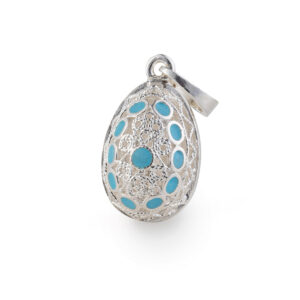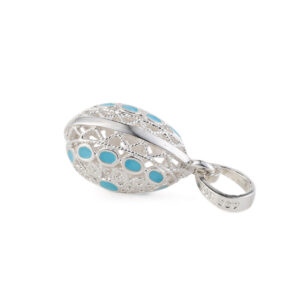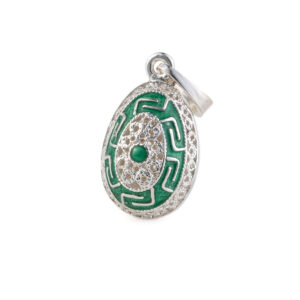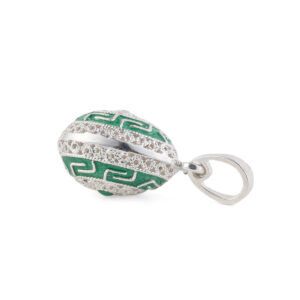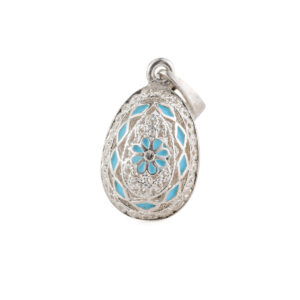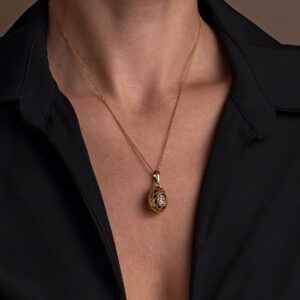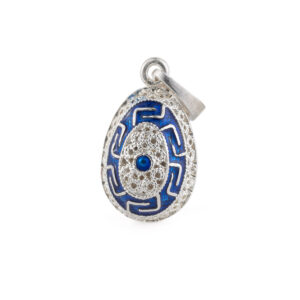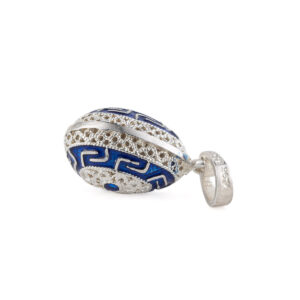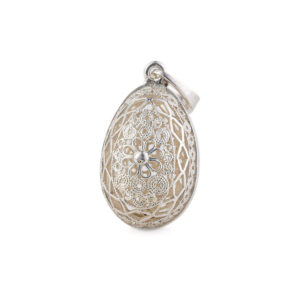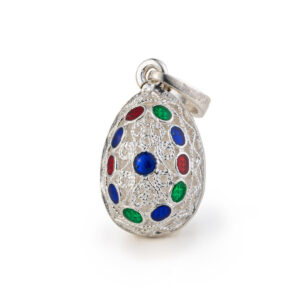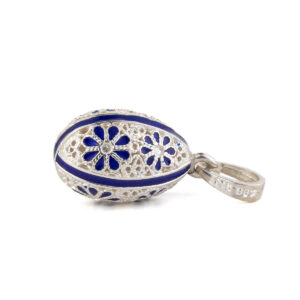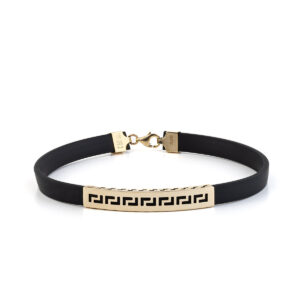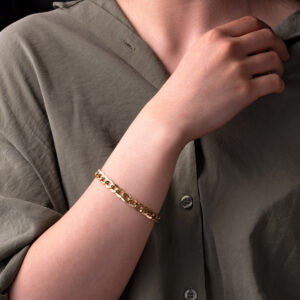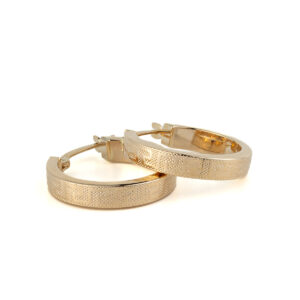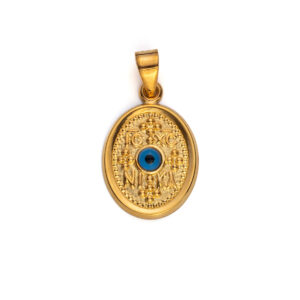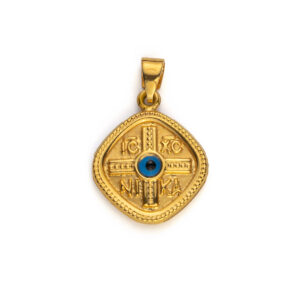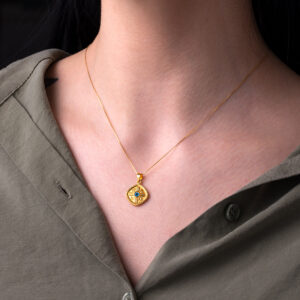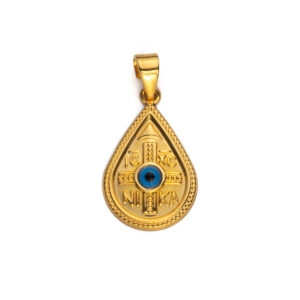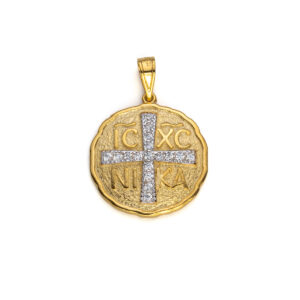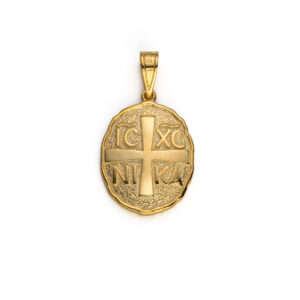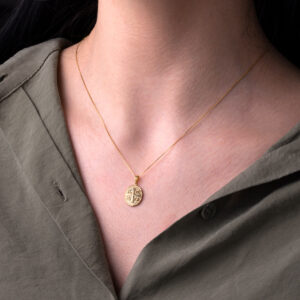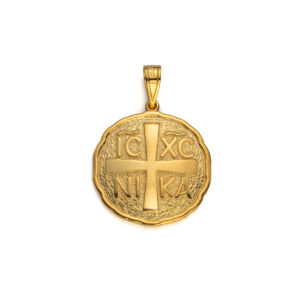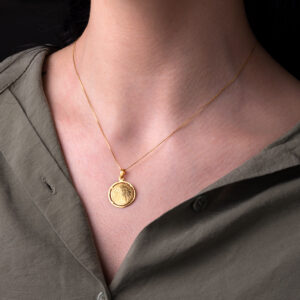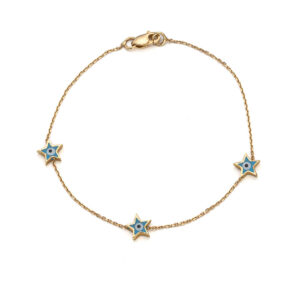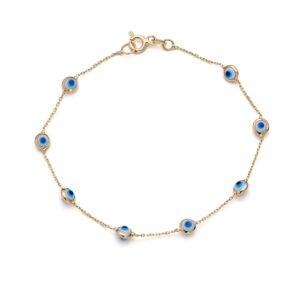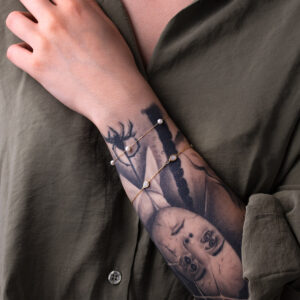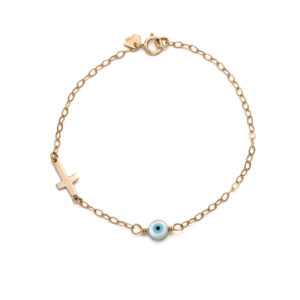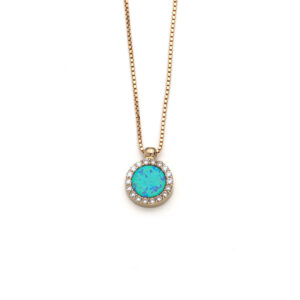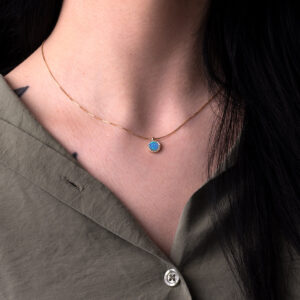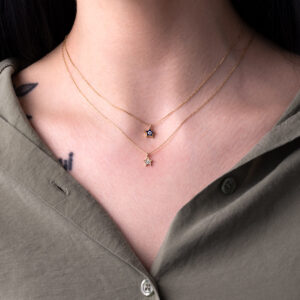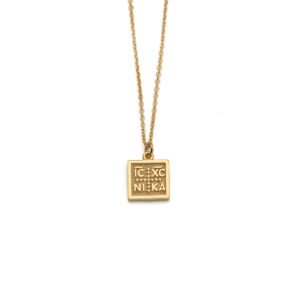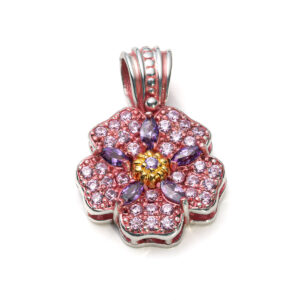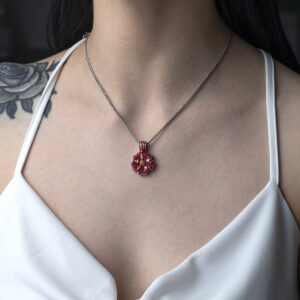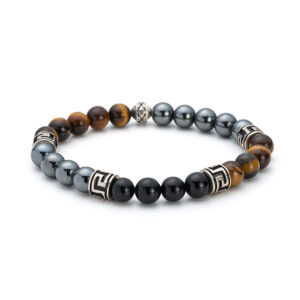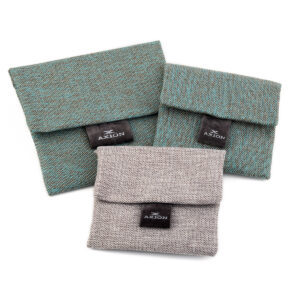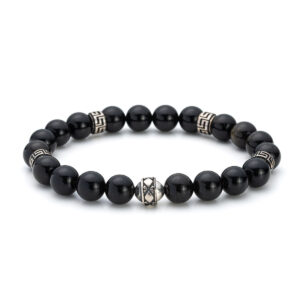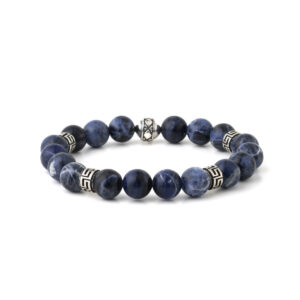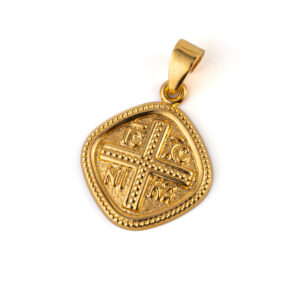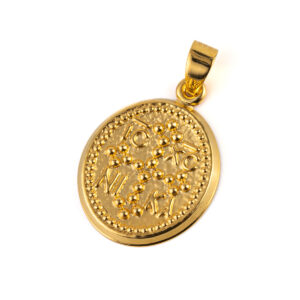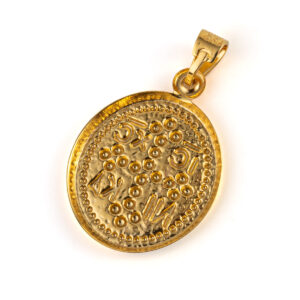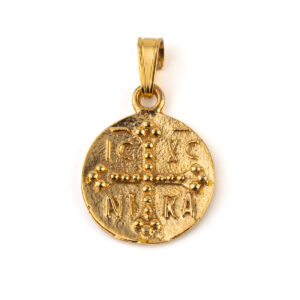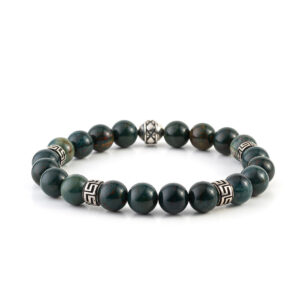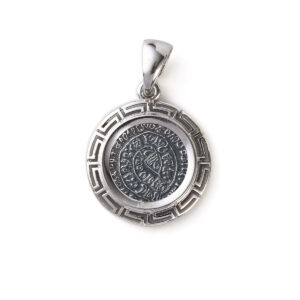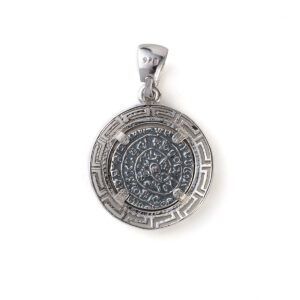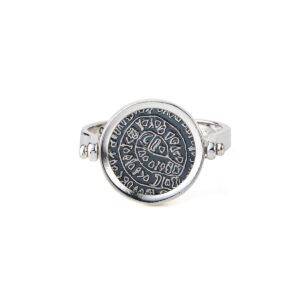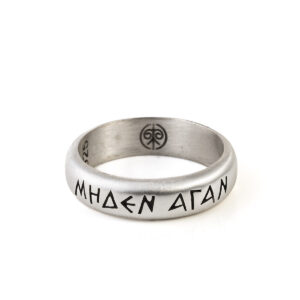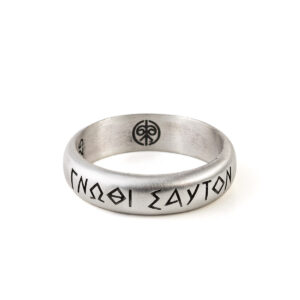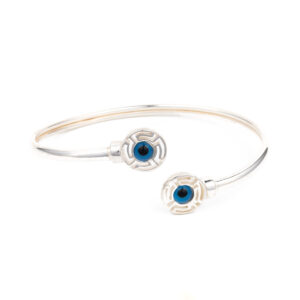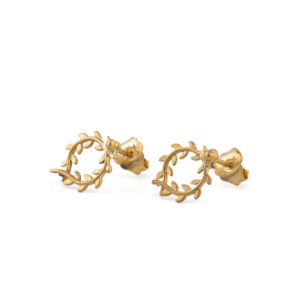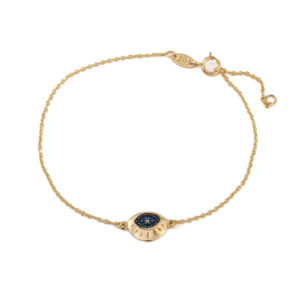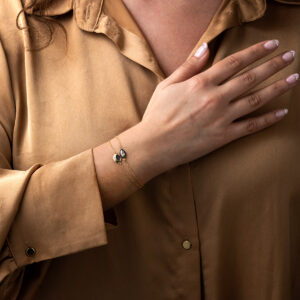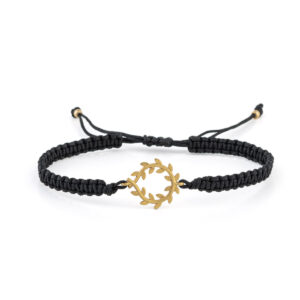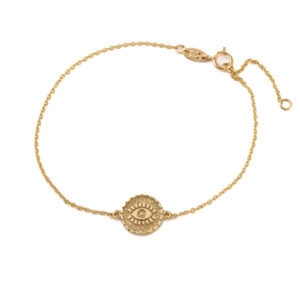Κολιέ με Μενταγιόν Αυγό – Ασήμι 925
The pendant is embellished with a fine filigree and enamel in Faberge style.
Made of 925 sterling silver.
Handmade in Greece.
The chain shown is included.
Filigree is a delicate kind of jewellery metalwork, made with tiny beads or twisted threads, or both in combination, soldered together or to the surface of an object of the same metal and arranged in artistic motifs. The art of filigree dates back to ancient history. The first of the found jewelry in this technique have been found in Mesopotamia and dates to thousands of years BC. In the ancient world and particularly in Asia Minor, this art grew were at the highest level.
Fabergé egg is a jeweled egg created by the House of Fabergé, in St. Petersburg, Imperial Russia. Virtually all were manufactured under the supervision of Peter Carl Fabergé between 1885 and 1917,[citation needed] the most famous being the 50 “Imperial” eggs, 43 of which survive, made for the Russian Tsars Alexander III and Nicholas II as Easter gifts for their wives and mothers. The first Fabergé egg was crafted for Tsar Alexander III, who had decided to give his wife, the Empress Maria Feodorovna, an Easter egg in 1885. Peter Carl Fabergé was a Russian jeweller best known for the famous Fabergé eggs made in the style of genuine Easter eggs, using precious metals and gemstones. He’s the founder of the famous jewelry legacy House of Fabergé.
Κολιέ με Μενταγιόν Αυγό – Ασήμι 925
The pendant is embellished with a fine filigree and enamel in Faberge style.
Made of 925 sterling silver.
Handmade in Greece.
The chain shown is included.
Filigree is a delicate kind of jewellery metalwork, made with tiny beads or twisted threads, or both in combination, soldered together or to the surface of an object of the same metal and arranged in artistic motifs. The art of filigree dates back to ancient history. The first of the found jewelry in this technique have been found in Mesopotamia and dates to thousands of years BC. In the ancient world and particularly in Asia Minor, this art grew were at the highest level.
Fabergé egg is a jeweled egg created by the House of Fabergé, in St. Petersburg, Imperial Russia. Virtually all were manufactured under the supervision of Peter Carl Fabergé between 1885 and 1917,[citation needed] the most famous being the 50 “Imperial” eggs, 43 of which survive, made for the Russian Tsars Alexander III and Nicholas II as Easter gifts for their wives and mothers. The first Fabergé egg was crafted for Tsar Alexander III, who had decided to give his wife, the Empress Maria Feodorovna, an Easter egg in 1885. Peter Carl Fabergé was a Russian jeweller best known for the famous Fabergé eggs made in the style of genuine Easter eggs, using precious metals and gemstones. He’s the founder of the famous jewelry legacy House of Fabergé.
Κολιέ με Μενταγιόν Αυγό – Ασήμι 925
The pendant is embellished with a fine filigree and enamel in Faberge style.
Made of 925 sterling silver.
Handmade in Greece.
The chain shown is included.
Filigree is a delicate kind of jewellery metalwork, made with tiny beads or twisted threads, or both in combination, soldered together or to the surface of an object of the same metal and arranged in artistic motifs. The art of filigree dates back to ancient history. The first of the found jewelry in this technique have been found in Mesopotamia and dates to thousands of years BC. In the ancient world and particularly in Asia Minor, this art grew were at the highest level.
Fabergé egg is a jeweled egg created by the House of Fabergé, in St. Petersburg, Imperial Russia. Virtually all were manufactured under the supervision of Peter Carl Fabergé between 1885 and 1917,[citation needed] the most famous being the 50 “Imperial” eggs, 43 of which survive, made for the Russian Tsars Alexander III and Nicholas II as Easter gifts for their wives and mothers. The first Fabergé egg was crafted for Tsar Alexander III, who had decided to give his wife, the Empress Maria Feodorovna, an Easter egg in 1885. Peter Carl Fabergé was a Russian jeweller best known for the famous Fabergé eggs made in the style of genuine Easter eggs, using precious metals and gemstones. He’s the founder of the famous jewelry legacy House of Fabergé.
Κολιέ με Μενταγιόν Αυγό – Ασήμι 925
The pendant is embellished with a fine filigree and enamel in Faberge style.
Made of 925 sterling silver.
Handmade in Greece.
The chain shown is included.
Filigree is a delicate kind of jewellery metalwork, made with tiny beads or twisted threads, or both in combination, soldered together or to the surface of an object of the same metal and arranged in artistic motifs. The art of filigree dates back to ancient history. The first of the found jewelry in this technique have been found in Mesopotamia and dates to thousands of years BC. In the ancient world and particularly in Asia Minor, this art grew were at the highest level.
Fabergé egg is a jeweled egg created by the House of Fabergé, in St. Petersburg, Imperial Russia. Virtually all were manufactured under the supervision of Peter Carl Fabergé between 1885 and 1917,[citation needed] the most famous being the 50 “Imperial” eggs, 43 of which survive, made for the Russian Tsars Alexander III and Nicholas II as Easter gifts for their wives and mothers. The first Fabergé egg was crafted for Tsar Alexander III, who had decided to give his wife, the Empress Maria Feodorovna, an Easter egg in 1885. Peter Carl Fabergé was a Russian jeweller best known for the famous Fabergé eggs made in the style of genuine Easter eggs, using precious metals and gemstones. He’s the founder of the famous jewelry legacy House of Fabergé.
Κολιέ με Μενταγιόν Αυγό – Ασήμι 925
The pendant is embellished with a fine filigree and enamel in Faberge style.
Made of 925 sterling silver.
Handmade in Greece.
The chain shown is included.
Filigree is a delicate kind of jewellery metalwork, made with tiny beads or twisted threads, or both in combination, soldered together or to the surface of an object of the same metal and arranged in artistic motifs. The art of filigree dates back to ancient history. The first of the found jewelry in this technique have been found in Mesopotamia and dates to thousands of years BC. In the ancient world and particularly in Asia Minor, this art grew were at the highest level.
Fabergé egg is a jeweled egg created by the House of Fabergé, in St. Petersburg, Imperial Russia. Virtually all were manufactured under the supervision of Peter Carl Fabergé between 1885 and 1917,[citation needed] the most famous being the 50 “Imperial” eggs, 43 of which survive, made for the Russian Tsars Alexander III and Nicholas II as Easter gifts for their wives and mothers. The first Fabergé egg was crafted for Tsar Alexander III, who had decided to give his wife, the Empress Maria Feodorovna, an Easter egg in 1885. Peter Carl Fabergé was a Russian jeweller best known for the famous Fabergé eggs made in the style of genuine Easter eggs, using precious metals and gemstones. He’s the founder of the famous jewelry legacy House of Fabergé.
Κολιέ με Μενταγιόν Αυγό – Ασήμι 925
The pendant is embellished with a fine filigree and enamel in Faberge style.
Made of 925 sterling silver.
Handmade in Greece.
The chain shown is included.
Filigree is a delicate kind of jewellery metalwork, made with tiny beads or twisted threads, or both in combination, soldered together or to the surface of an object of the same metal and arranged in artistic motifs. The art of filigree dates back to ancient history. The first of the found jewelry in this technique have been found in Mesopotamia and dates to thousands of years BC. In the ancient world and particularly in Asia Minor, this art grew were at the highest level.
Fabergé egg is a jeweled egg created by the House of Fabergé, in St. Petersburg, Imperial Russia. Virtually all were manufactured under the supervision of Peter Carl Fabergé between 1885 and 1917,[citation needed] the most famous being the 50 “Imperial” eggs, 43 of which survive, made for the Russian Tsars Alexander III and Nicholas II as Easter gifts for their wives and mothers. The first Fabergé egg was crafted for Tsar Alexander III, who had decided to give his wife, the Empress Maria Feodorovna, an Easter egg in 1885. Peter Carl Fabergé was a Russian jeweller best known for the famous Fabergé eggs made in the style of genuine Easter eggs, using precious metals and gemstones. He’s the founder of the famous jewelry legacy House of Fabergé.
Κολιέ με Μενταγιόν Αυγό – Ασήμι 925
The pendant is embellished with a fine filigree and multicolor enamel in Faberge style.
Made of 925 sterling silver.
Handmade in Greece.
The chain shown is included.
Filigree is a delicate kind of jewellery metalwork, made with tiny beads or twisted threads, or both in combination, soldered together or to the surface of an object of the same metal and arranged in artistic motifs. The art of filigree dates back to ancient history. The first of the found jewelry in this technique have been found in Mesopotamia and dates to thousands of years BC. In the ancient world and particularly in Asia Minor, this art grew were at the highest level.
Fabergé egg is a jeweled egg created by the House of Fabergé, in St. Petersburg, Imperial Russia. Virtually all were manufactured under the supervision of Peter Carl Fabergé between 1885 and 1917,[citation needed] the most famous being the 50 “Imperial” eggs, 43 of which survive, made for the Russian Tsars Alexander III and Nicholas II as Easter gifts for their wives and mothers. The first Fabergé egg was crafted for Tsar Alexander III, who had decided to give his wife, the Empress Maria Feodorovna, an Easter egg in 1885. Peter Carl Fabergé was a Russian jeweller best known for the famous Fabergé eggs made in the style of genuine Easter eggs, using precious metals and gemstones. He’s the founder of the famous jewelry legacy House of Fabergé.
Κολιέ με Μενταγιόν Αυγό – Ασήμι 925
The pendant is embellished with a fine filigree and blue enamel in Faberge style.
Made of 925 sterling silver.
Handmade in Greece.
The chain shown is included.
Filigree is a delicate kind of jewellery metalwork, made with tiny beads or twisted threads, or both in combination, soldered together or to the surface of an object of the same metal and arranged in artistic motifs. The art of filigree dates back to ancient history. The first of the found jewelry in this technique have been found in Mesopotamia and dates to thousands of years BC. In the ancient world and particularly in Asia Minor, this art grew were at the highest level.
Fabergé egg is a jeweled egg created by the House of Fabergé, in St. Petersburg, Imperial Russia. Virtually all were manufactured under the supervision of Peter Carl Fabergé between 1885 and 1917,[citation needed] the most famous being the 50 “Imperial” eggs, 43 of which survive, made for the Russian Tsars Alexander III and Nicholas II as Easter gifts for their wives and mothers. The first Fabergé egg was crafted for Tsar Alexander III, who had decided to give his wife, the Empress Maria Feodorovna, an Easter egg in 1885. Peter Carl Fabergé was a Russian jeweller best known for the famous Fabergé eggs made in the style of genuine Easter eggs, using precious metals and gemstones. He’s the founder of the famous jewelry legacy House of Fabergé.
Βραχιόλι με Μαίανδρο – 14Κ Χρυσό
472,00€Σκουλαρίκια Κρίκοι με Μαίανδρο – Χρυσό 14Κ
278,00€ – 428,00€Φτιαγμένο από χρυσό 14Κ.
Χειροποίητο κόσμημα.
Κωνσταντινάτο Μενταγιόν Οβάλ με Μάτι – 9Κ Χρυσό
135,00€Κατασκευασμένο από Χρυσό 9Κ.
Χειροποίητο Ελληνικό Κόσμημα.
Κωνσταντινάτο Μενταγιόν Ρόμβος – 9Κ Χρυσό
198,00€Κατασκευασμένο από Χρυσό 9Κ.
Χειροποίητο Ελληνικό Κόσμημα.
Κωνσταντινάτο Μενταγιόν Σταγόνα – 9Κ Χρυσό
162,00€Κατασκευασμένο από Χρυσό 9Κ.
Χειροποίητο Ελληνικό Κόσμημα.
Μενταγιόν Κωνσταντινάτο με Σταυρό – 9Κ Χρυσό
267,00€ – 357,00€Κατασκευασμένο από Χρυσό 9Κ.
Χειροποίητο Ελληνικό Κόσμημα.
Κωνσταντινάτο Μενταγιόν Οβάλ – 9Κ Χρυσό
215,00€Κατασκευασμένο από Χρυσό 9Κ.
Χειροποίητο Ελληνικό Κόσμημα.
Κωνσταντινάτο Μενταγιόν – 9Κ Χρυσό
232,00€ – 357,00€A handmade gold pendant that depicts Saints Constantine and Helena on the one side and Christogram with the initials IC XC NIKA (Jesus Christ conquers) on the other side.
Is a unique pendant which you can offer to your special ones as a protection gift or buy it for yourself.
Made of 9k gold.
Handmade in Greece
Κωνσταντινάτο Μενταγιόν Στρογγυλό – 9Κ Χρυσό
195,00€Κατασκευασμένο από Χρυσό 9Κ.
Χειροποίητο Ελληνικό Κόσμημα.
Βραχιόλι Μάτι με Αστέρια – 14Κ Χρυσό
365,00€Made of 14K yellow gold
Handmade in Greece
The symbol and superstition of the evil eye is one of the strongest symbolic images in the world. The earliest known evidence for belief in the evil eye goes back to ancient Greece and Rome. It is supposed to wear off evil to anyone who wears it.
Μενταγιόν Λουλούδι με Swarovski
Κατασκευασμένο από επιχρυσωμένο ασήμι 925 και διακοσμημένο με πέτρα μαλαχίτη.
Χειροποίητο ελληνικό κόσμημα.
Βραχιόλι Μαίανδρος με Πέτρες Onyx Hematite Tiger Eye Beads – Ασήμι 925
Κατασκευασμένο από ασήμι 925.
Χειροποίητο ελληνικό κόσμημα.
Βραχιόλι Μαίανδρος με Sodalite Πέτρες – Ασήμι 925
Κατασκευασμένο από ασήμι 925.
Χειροποίητο ελληνικό κόσμημα.
Βραχιόλι Μαίανδρος με Obsidian Πέτρες – Ασήμι 925
Βραχιόλι εύκαμπτο με obsidian χάντρες 10mm
Κατασκευασμένο από ασήμι 925.
Χειροποίητο ελληνικό κόσμημα.
Μενταγιόν Κωνσταντινάτο Ρόμβος – 14Κ Χρυσό
132,00€ – 149,00€A handmade gold pendant that depicts Christogram with the initials IC XC NIKA (Jesus Christ conquers).
Is a unique necklace which you can offer to your special ones as a protection gift or buy it for yourself.
Handmade with the great attention to detail.
Made of 14k gold.
Μενταγιόν Κωνσταντινάτο Σκαλιστό – 14Κ Χρυσό
238,00€ – 320,00€Κατασκευασμένο από Χρυσό 14Κ.
Χειροποίητο Ελληνικό Κόσμημα.
Βραχιόλι Μαίανδρος με Πέτρες – Ασήμι 925
Κατασκευασμένο από ασήμι 925.
Χειροποίητο ελληνικό κόσμημα.
Μενταγιόν Δίσκος Φαιστού με Μαίανδρο – Ασήμι 925
Κατασκευασμένα από ασήμι 925.
Ο Δίσκος της Φαιστού είναι ένας δίσκος από πηλό από το μινωικό παλάτι της Φαιστού στο νησί της Κρήτης. Τώρα, το νησί της Κρήτης είναι μέρος της σύγχρονης Ελλάδας. Ο δίσκος ανακαλύφθηκε το 1908 από τον Ιταλό αρχαιολόγο Luigi Pernier στο μινωικό παλάτι της Φαιστού. Ακόμα και στις μέρες μας η αποκρυπτογράφηση του δεν είναι ξεκάθαρη, καθιστώντας το ένα από τα πιο διάσημα μυστήρια της αρχαιολογίας. Ο δίσκος έχει διάμετρο περίπου 15 εκατοστά και καλύπτεται και στις δύο πλευρές με μια σπείρα από σφραγισμένα σύμβολα. Ο δίσκος διαθέτει 241 μάρκες, που περιλαμβάνουν 45 ξεχωριστά σημάδια, τα οποία φτιάχτηκαν προφανώς πιέζοντας ιερογλυφικές «σφραγίδες» σε ένα δίσκο από μαλακό πηλό, με μια δεξιόστροφη ακολουθία που στρέφεται προς το κέντρο του δίσκου. Αυτό το μοναδικό αντικείμενο εκτίθεται τώρα στο αρχαιολογικό μουσείο Ηρακλείου.
Χειροποίητο ελληνικό κόσμημα.
Δαχτυλίδι με τον Δίσκο της Φαιστού – Ασήμι 925 Επιχρυσωμένο
Κατασκευασμένο από ασήμι 925 επιχρυσωμένο.
Χειροποίητο ελληνικό κόσμημα.
Δαχτυλίδι με τον Δίσκο της Φαιστού – Ασήμι 925
Κατασκευασμένο από ασήμι 925.
Χειροποίητο ελληνικό κόσμημα.
Μeden Αgan Ring – 925 Sterling Silver
Made of 925⁰ sterling silver.
Handmade item.
“Nothing (in) excess” meaning you should find the golden mean in everything, avoid extremities (by Chilon of Sparta one of the seven sages of ancient Greece)
The phrase ‘meden agan’ are written on the temple at Delphi.
Gnōthi Seauton Ring – 925 Sterling Silver
The Ancient Greek aphorism “know thyself” (Greek: γνῶθι σεαυτόν, transliterated: gnōthi seauton) is one of the Delphic maxims and was the first of three maxims inscribed in the pronaos of the Temple of Apollo at Delphi according to the Greek writer Pausanias. This aphorism used numerous times in the dialogues of Socrates by Plato.
Made of 925⁰ sterling silver.
Handmade item.
Βυζαντινός Σταυρός – 18Κ Χρυσό
628,00€Byzantine Cross embellished with a fine filigree.
Handmade with the great attention to detail. Inspired by Byzantine art.
Made in 18k gold
Filigree is a delicate kind of jewellery metalwork, made with tiny beads or twisted threads, or both in combination, soldered together or to the surface of an object of the same metal and arranged in artistic motifs. The art of filigree dates back to ancient history. The first of the found jewelry in this technique have been found in Mesopotamia and dates to thousands of years BC. In the ancient world and particularly in Asia Minor, this art grew were at the highest level.
Σκουλαρίκια Στεφάνι Ελιάς – 14Κ Κίτρινο Χρυσό
364,00€Κατασκευασμένα από 14Κ Χρυσό
Το στεφάνι ελιάς ήταν το έπαθλο του νικητή στους αρχαίους Ολυμπιακούς Αγώνες. Σύμφωνα με τον Παυσανία, εισήχθη από τον Ηρακλή ως έπαθλο για τον νικητή των αγώνων, για να τιμήσει τον πατέρα του Δία. Στους αρχαίους Ολυμπιακούς Αγώνες δεν υπήρχαν χρυσά, αργυρά ή χάλκινα μετάλλια. Υπήρχε μόνο ένας νικητής ανά εκδήλωση, ο οποίος στέφονταν με ένα στεφάνι ελιάς.
Χειροποίητο Ελληνικό Κόσμημα.
Δαχτυλίδι με Κλαδί Ελιάς – 14Κ Χρυσό
215,00€Αυτά τα ασημένια σκουλαρίκια είναι εμπνευσμένα από το αρχαίο στεφάνι ελιάς!
Κατασκευασμένα από χρυσό 14Κ.
Το στεφάνι ελιάς ήταν το έπαθλο του νικητή στους αρχαίους Ολυμπιακούς Αγώνες. Σύμφωνα με τον Παυσανία, εισήχθη από τον Ηρακλή ως έπαθλο για τον νικητή των αγόνων, για να τιμήσει τον πατέρα του Δία. Στους αρχαίους Ολυμπιακούς Αγώνες δεν υπήρχαν χρυσά, αργυρά ή χάλκινα μετάλλια. Υπήρχε μόνο ένας νικητής ανά εκδήλωση, ο οποίος στέφονταν με ένα στεφάνι ελιάς.
Χειροποίητο ελληνικό κόσμημα.
Μακραμέ Βραχιόλι Στεφάνι Ελιάς – 14Κ Χρυσό
178,00€Κατασκευασμένα από χρυσό 14Κ.
Το στεφάνι ελιάς ήταν το έπαθλο του νικητή στους αρχαίους Ολυμπιακούς Αγώνες. Σύμφωνα με τον Παυσανία, εισήχθη από τον Ηρακλή ως έπαθλο για τον νικητή των αγόνων, για να τιμήσει τον πατέρα του Δία. Στους αρχαίους Ολυμπιακούς Αγώνες δεν υπήρχαν χρυσά, αργυρά ή χάλκινα μετάλλια. Υπήρχε μόνο ένας νικητής ανά εκδήλωση, ο οποίος στέφονταν με ένα στεφάνι ελιάς.

